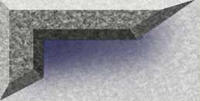|
There are three types of panel technologies - Amorphous (thin film), Poly-Crystalline (multi-crystal), and Mono-Crystalline
(single crystal). Each of these is made slightly differently and has different benefits.
You probably will not use amorphous panels. These are thin, flexible panels and are useful on curved surfaces. They can be
directly mounted with no air space. They are not quite as efficient as the other panels, so they take up more room for the
same amount of power. They also cost slightly more. But they are useful in certain circumstances, such as in extremely hot
conditions, since they deal with heat better. Unisolar is one of the leading sellers of amorphous panels.
I won’t go into how the panels are made; you can search the net if you are curious. All panels have a number of “cells”
that individually produce (more or less) 0.5 volts. So, to have sufficient voltage for RV battery charging requires a panel
that has at least 36 cells, connected in series. In practice, this 36 cell panel can produce up to 18 (usable) volts, or so.
It does vary depending on the manufacturer.
Why do we need so much voltage when we are charging a 12-volt battery? Because 18 volts is the manufacturers “rating”
under a certain set of standard test criteria. In practice, we rarely have these “optimal” conditions. To ensure
that the required voltage is available at the solar controller and batteries, we need to have a higher input voltage. You
need a minimum of about 16.5 (rated) volts to have a decent system in an RV application. Remember, you need to apply somewhere
in the range of 14.1 to 14.4 volts to your battery bank to achieve a full charge.
What affects our use of solar panels in an RV environment? First is heat. Panels are rated at 77 degrees. That’s
the panel temperature itself, not the air. Think about the top of your RV in full sun – the panels are much hotter than
that, and drop voltage because of the heat. They are also mounted about an inch (or so) from your roof, so ventilation is
not the best. Second, is solar orientation. The angle of the sun changes seasonally. In the winter, it is very low in the
sky. You don’t generally use a sun tracker on an RV, so your panels are generally not optimally oriented for full solar
gain. In fact, you may choose to never tilt your panels, leaving them flat on your roof for convenience. Next, is shade. Are
your panels partially shaded? Does your air conditioner cast a shadow sometime during the day? Does your crank up antenna?
What about all the dust/dirt on the panel surface? Last, is wiring. You are going to drop some voltage due to wire loss between
the panel and batteries. These considerations apply to all panel types.
So, how many panels do you need? You have
an idea of the total amp hours (or watts) you use daily. To figure how much power a panel produces, take its “rating”
(lets say 120 watts, or 7.1 amps) and multiply that by 5. This assumes you are getting 5 hours of sun a day (optimal) and
that your panels really are producing at their rated output – neither of which will be true most of the time. But it
is good for estimating. Now divide this total output of one panel into the number of watts/amp you use daily. So, for example,
I have Kyocera 120 panels (120 watts, 7.1 amps). I’ll use amps to figure the required panels. I know I use 100 amp hours
a day, from my previous figuring. So 100 / (7.1x 5) = 100/35.5 = 3 panels (with rounding). But, I know I leave my panels flat,
and I know not every day is sunny so I’ll use 4 panels. In my case, I started with 3 and added the fourth later, after
I was experienced with our use.
Rules of thumb:
- Figure on a max of 5 hours of solar at the panels rating.
- Most experts recommend one watt of panel for each amp of battery bank. So, a bank of 4 - T105's that are rated around
440 amphours would be paired with a solar array of around 400-450 watts (about 4 Kyocera 120 watt panels). In this example,
you could start with 3 panels and expand later, if needed.
- You gain as much as 30% by tilting your panels (over them being flat – especially in the winter when the sun is
low). The proper way to think of this is actually that you loose 30% of your rated output if you don’t tilt your panels.
- Most Rvers that are regular boondocker's use 100 - 125 amps DC a day. More or less. If you are frugal you will use less
– sometimes far less. If you are liberal, you will use more. We know people who use 600+ amps a day.
- You loose up to 30% of the stored power when you are inverting (heat, inverter inefficiencies, and wire loss).
- You loose up to 20% of the stored power when you use DC directly.
- The colder it is, the better solar panels operate. Their rating is at 77 degrees F.
- The colder it is, the WORSE batteries perform. See the dilemma?
|

